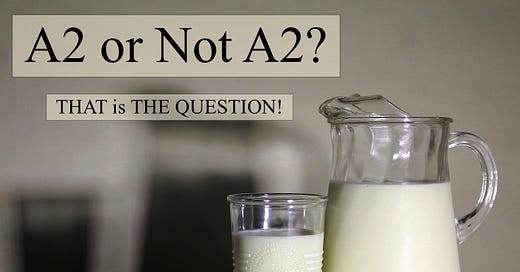Are you being duped about A2 milk?
How did this trend start - science or a clever patenting and marketing scheme? Are farmers being truthful about their status?
Welcome to Raw Milk Mama, a newsletter about food freedom, our food systems, and how to create local food security in our communities. Sign up here for weekly posts, or keep reading…
If you value this content, please consider a paid subscription.
I know that for those who care about A2 milk, you care a lot. For anyone unaware of this nutritional niche, this article provides a short rundown so you can use your own discernment to figure out which details to explore further and how to find a farm that fits your needs.
Here’s what we’ll cover in this article:
A2 milk – the origins and science behind the claims.
Marketing and messaging vs. reality.
How much should you be paying for it?
A2 milk – the origins and the science
It appears that many years ago – more than 1000 by most assessments – some cows had a natural genetic mutation in which a specific beta-casein (milk protein) changed from the A2 protein to an A1 protein.
No one really knew about it at the time, obviously.
In the late 1900’s, New Zealand researcher and entrepreneur, Corran McLachlan, began studying the A1 beta-casein in milk.
McLachlan’s research “concluded a strong link between the consumption of the A1 beta casein protein and Ischaemic heart disease, childhood Type 1 diabetes and other ailments, and he believed that many people thought to have lactose intolerance are instead sensitive to the A1 protein.”
One could reasonably suggest, at this point, for people sensitive to the A1 protein in cow’s milk to switch to drinking goat, sheep, or water buffalo milk from small, local farms since these other types of milk have almost exclusively the A2 protein.
But that would be too easy.
This is where McLachlan’s solution came into play: “using a genetic test, McLachlan was able to identify cows that produce only the A2 protein. McLachlan's conclusions were not accepted among all scientists; many pointed out that the research was ‘correlative, rather than proven cause and effect’” (Wiki)
But, the test was patented and the implications had started: ordinary, untested cow milk was dangerous.
One of the best ways to scare people into new buying patterns is to give them serious concern about disease. In this case, heart disease, type 1 diabetes and a general intolerance to milk caused by mysterious, unknown factors.
So what is the exact science behind these claims?
Keep reading with a 7-day free trial
Subscribe to Raw Milk Mama to keep reading this post and get 7 days of free access to the full post archives.





